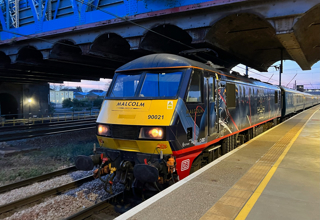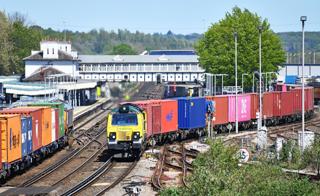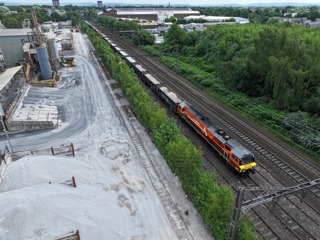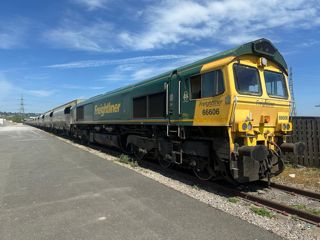
Network Rail has officially said it is not supporting three open access proposals for the West Coast Main Line (WCML).

Network Rail has officially said it is not supporting three open access proposals for the West Coast Main Line (WCML).
In final representations sent to the Office of Rail and Road (ORR), NR’s Customer Relationships Executive, Rob Neep, explained why Lumo’s Euston-Rochdale, Virgin’s Euston-Birmingham New Street/Liverpool Lime Street/Preston/Rochdale and Wrexham, Shropshire and Midlands Railway’s (WSMR) Euston-Wrexham plans were not being backed.
NR had previously indicated it would not be supporting the plans in general submissions about WCML track access applications.
WCML Fast Line capacity between Euston and Rugby is highlighted in all three letters, with Neep writing: “Network Rail believes any additional services on the Fast Lines on the WCML South would have a significant detrimental impact to performance where the current quantum of services, combined with the realities of operating a mixed traffic railway, already have significant performance challenges and contribute to delivering performance at a level below expected levels.”
He said NR had “identified some potential theoretical capacity on a Sunday for a very small number of paths”, but admitted it was “unlikely that a new operator could use this as a foundation to start and manage a new business operation”.
Even then, NR does not want this capacity used due to performance or operational risks or the effects it could have on engineering plans and diversionary requirements.
Lumo and Virgin

NR has raised capacity concerns around Manchester, specifically at Ordsall Lane Junction, Manchester Victoria and Rochdale, with platform space at both stations a concern.
Two platforms at Rochdale can take trains from the west (such as Lumo’s and Virgin’s), but one is not signalled for a reversal and the other is too short for both operators’ purposes.
Plans to use the Calder Valley Line have also concerned NR, which says the route has diversionary capacity for up to three trains per hour to support the Manchester-Leeds corridor as part of the Transpennine Route Upgrade.
“Adding additional paths to the WCML Fast Lines would mean reducing the capacity for the diversionary route. Consequently, engineering access is less likely to be supported by operators, significantly driving up the cost of delivering work,” Neep said.
“This has a lasting impact to passenger numbers, which having largely recovered from COVID, would then be impacted significantly by disruption and may turn to alternative forms of transport. There are over 83 days of diversion planned in 2026/27 with over 100 days of diversion needed from 2029/30.”
As well as capacity, NR does not support plans for electric traction to be used along the WCML due to power supply constraints. Last year, the FirstGroup-owned operator said it would order Hitachi bi-mode units for the route if ORR gave approval.
While Virgin plans to avoid using Manchester’s Castlefield Corridor, NR raised performance concerns relating to crossing moves at Heaton Norris Junction and Miles Platting.

NR also highlighted the Manchester Taskforce Board which has reformed timetables in the city to “remove train services that could not be operated practicably to maintain the overall operational integrity of these critical corridors”.
NR has said “strategic planning for the current and future timetable structure is founded on this approach to capacity utilisation, at least until infrastructure capacity is increased” in a future Configuration State which currently doesn’t have fully agreed delivery funding.
The impact of HS2 is also referenced, with Neep commenting that once the new route is up and running “it will therefore be necessary to reduce the current train service by approximately one path for every HS2 path introduced” north of Handsacre Junction.
WSMR
Focusing on WSMR, Neep’s letter also highlighted poor performance at Nuneaton and Water Orton where the on-time performance was 39.2% and 44.3% respectively.
It also said there was “numerous non-compliances between the proposed WSMR paths and other existing services” which NR “did not believe could be easily resolved through the flexing of other operators’ services”.
It also said the additional services between Wrexham and Shrewsbury would lead to an intolerable increase of risk at a footpath crossing just south of Chirk.
NR reported observing children and elderly users of the crossing with nearly half deemed “vulnerable” who take extra time to cross due to disability or distraction.
“The vulnerable users at this location are people in large groups, distracted users on their phones or wearing head phones, users leaving the deck and entering the cess along with elderly users,” Neep’s letter explained.
“Viaduct Level Crossing is already on a list of non-compliant crossings highlighted by ORR due to having only one whistle board that provides an inconsistent warning. We are aware that a second whistle board may be feasible to be installed; however, this only keeps the crossing at its current risk level making it compliant with a consistent warning.”
More feasibility work would be needed for a second whistle board to be installed.
Login to continue reading
Or register with RAIL to keep up-to-date with the latest news, insight and opinion.

















Stephen Lee - 14/05/2025 13:00
Perhaps these open access operations can try again once HS2 opens.